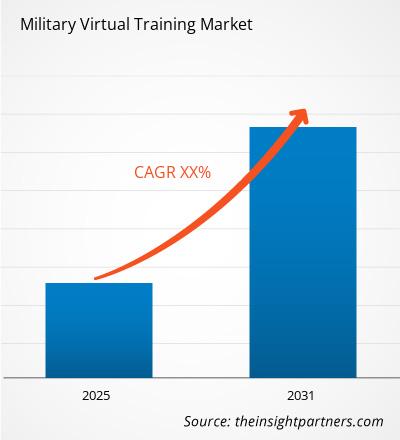MARKET INTRODUCTION
Military virtual training are progressively getting adopted by the armed forces of many countries across the globe. They help reduce training costs as they are based on Commercial-off-the-Shelf (COTS) components. The increasing investments in virtual software are anticipated to be one of the important factors driving the market growth. Also, defense ministries of different countries are reorganizing and modifying their militaries with innovative solutions, which, in turn, is driving the market.
MARKET DYNAMICS
The rising need for trained workforce in the military coupled with rising demand for conventional and unconventional military equipment and software is anticipated to drive the military virtual training market. Military virtual training help reduce the wear and tear of equipment, enables cost savings, and provides the ability to meet varied requirements, which is resulting in the overall market growth. Moreover, the defense ministries of many countries are reducing their training budgets and are downscaling the militaries. This has increased the focus of the military in attaining cheaper and effective solutions for their requirement. These factors are expected to further drive the market over the forecast period.
MARKET SCOPE
The "Global Military Virtual Training Market Analysis to 2031" is a specialized and in-depth study of the military virtual training market with a special focus on the global market trend analysis. The report aims to provide an overview of military virtual training market with detailed market segmentation by type, application. The global military virtual training market expected to witness high growth during the forecast period. The report provides key statistics on the market status of the leading military virtual training market player and offers key trends and opportunities in the military virtual training market.
MARKET SEGMENTATION
The global military virtual training market is segmented on the basis of type, application. On the basis of type, market is segmented as traditional military virtual training, virtual reality based military training. On the basis of application, market is segmented as flight simulation, battlefield simulation, medic training (battlefield), vehicle simulation, virtual boot camp.
REGIONAL FRAMEWORK
The report provides a detailed overview of the industry including both qualitative and quantitative information. It provides overview and forecast of the global military virtual training market based on various segments. It also provides market size and forecast estimates from year 2021 to 2031 with respect to five major regions, namely; North America, Europe, Asia-Pacific (APAC), Middle East and Africa (MEA) and South America. The military virtual training market by each region is later sub-segmented by respective countries and segments. The report covers analysis and forecast of 18 countries globally along with current trend and opportunities prevailing in the region.
The report analyzes factors affecting military virtual training market from both demand and supply side and further evaluates market dynamics effecting the market during the forecast period i.e., drivers, restraints, opportunities, and future trend. The report also provides exhaustive Porter's five forces analysis highlighting factors effecting the military virtual training market in these regions.
MARKET PLAYERS
The reports cover key developments in the military virtual training market organic and inorganic growth strategies. Various companies are focusing on organic growth strategies such as product launches, product approvals and others such as patents and events. Inorganic growth strategies activities witnessed in the market were acquisitions, and partnership & collaborations. These activities have paved way for expansion of business and customer base of market players. The market players from military virtual training market are anticipated to lucrative growth opportunities in the future with the rising demand for military virtual training market. Below mentioned is the list of few companies engaged in the military virtual training market.
The report also includes the profiles of key military virtual training market companies along with their SWOT analysis and market strategies. In addition, the report focuses on leading industry players with information such as company profiles, components and services offered, financial information of last 3 years, key development in past five years.
- L-3 Link Simulation and Training
- Boeing
- CAE Inc
- FlightSafety International
- Thales Group
- Lockheed Martin
- Cubic Corporation
- Rheinmetall Defence
- Raytheon Company
- Rockwell Collins
The Insight Partner's dedicated research and analysis team consist of experienced professionals with advanced statistical expertise and offer various customization options in the existing study.
Military Virtual Training Report Scope
| Report Attribute | Details |
|---|---|
| Market size in 2024 | US$ XX million |
| Market Size by 2031 | US$ XX Million |
| Global CAGR (2025 - 2031) | XX% |
| Historical Data | 2021-2023 |
| Forecast period | 2025-2031 |
| Segments Covered |
By Type
|
| Regions and Countries Covered | North America
|
| Market leaders and key company profiles |
- Historical Analysis (2 Years), Base Year, Forecast (7 Years) with CAGR
- PEST and SWOT Analysis
- Market Size Value / Volume - Global, Regional, Country
- Industry and Competitive Landscape
- Excel Dataset



Report Coverage
Revenue forecast, Company Analysis, Industry landscape, Growth factors, and Trends

Segment Covered
This text is related
to segments covered.

Regional Scope
North America, Europe, Asia Pacific, Middle East & Africa, South & Central America

Country Scope
This text is related
to country scope.
Trends and growth analysis reports related to Aerospace and Defense : READ MORE..
The List of Companies
1. L-3 Link Simulation and Training
2. Boeing
3. CAE Inc
4. FlightSafety International
5. Thales Group
6. Lockheed Martin
7. Cubic Corporation
8. Rheinmetall Defence
9. Raytheon Company
10. Rockwell Collins
1. L-3 Link Simulation and Training
2. Boeing
3. CAE Inc
4. FlightSafety International
5. Thales Group
6. Lockheed Martin
7. Cubic Corporation
8. Rheinmetall Defence
9. Raytheon Company
10. Rockwell Collins

 Get Free Sample For
Get Free Sample For